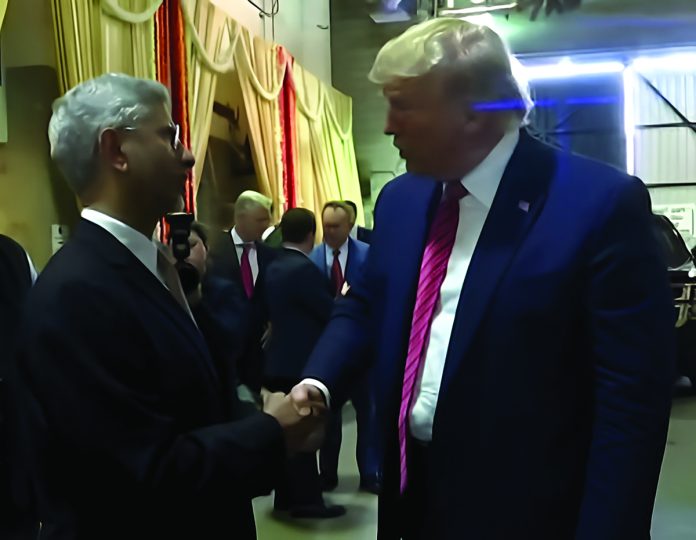Mirza Kashif Baig
As President Donald Trump embarks on his second term, the international community is keenly observing the administration’s foreign policy directions, mainly concerning key global players such as Russia, China, India, and Pakistan and the ongoing conflict in Ukraine.
The early diplomatic engagements, notably the prominence given to India’s External Affairs Minister during the inauguration and the subsequent Quadrilateral Security Dialogue (Quad) meeting, offer insights into the administration’s strategic priorities.
Engagement with India and the quad’s strategic significance
The attendance of India’s External Affairs Minister, Dr. S. Jaishankar, at President Trump’s inauguration underscores the administration’s importance on U.S.-India relations. Following the inauguration, a Quad meeting was convened, involving the foreign ministers of India, Japan, Australia, and the newly appointed U.S. Secretary of State, Marco Rubio.
This gathering in Washington D.C. was among the administration’s first major diplomatic engagements, signaling a renewed commitment to the Indo-Pacific region. In a press conference, Dr. Jaishankar highlighted the productive nature of his discussions with Secretary Rubio and National Security Adviser Mike Waltz.
He emphasized the shared vision of both nations, stating, “I think we have an extreme degree of trust today between India and the United States, a very high level of convergence of our interests.” This sentiment reflects a mutual desire to strengthen bilateral ties and collaborate on regional and global issues.
The Quad meeting culminated in a communique reaffirming the member nations’ commitment to a “free and open Indo-Pacific.” The statement emphasized enhancing the region’s maritime, economic, and technological security, aiming to counterbalance China’s growing influence. The Quad’s role as a strategic forum has been pivotal in addressing regional challenges, and its revitalization under the current administration indicates a concerted effort to bolster alliances in the Indo-Pacific.
Approach to Russia and the Ukraine conflict
President Trump’s approach to the ongoing conflict in Ukraine has been a focal point of his foreign policy. During his campaign, he asserted that he could swiftly negotiate an end to the war. However, in his inaugural address, he acknowledged the complexities involved, suggesting that achieving peace would require several months due to the entrenched positions of both Ukraine and Russia.
The administration’s strategy appears to center on applying economic pressure on Russia. Plans include leveraging diplomacy and targeting Russia’s oil revenue by collaborating with Saudi Arabia and OPEC to lower global oil prices, reducing Russia’s financial capacity to sustain the war. Additionally, the U.S. may continue supplying arms to Ukraine, financed by seizing Russian assets. This multifaceted approach aims to bring Russia to the negotiating table while bolstering Ukraine’s defense capabilities.
Relations with China: balancing competition and cooperation
The Trump administration’s stance toward China is characterized by competition and cautious engagement. Despite previous threats, the administration has deferred imposing new tariffs on China, opting to re-evaluate the economic relationship and continue negotiations. President Trump has emphasized cooperation with China in ending the Ukraine war and addressing issues like the fentanyl crisis. This approach reflects a recognition of China’s significant role in global affairs and the necessity of collaboration on shared challenges.
However, the administration remains vigilant regarding China’s trade, climate, and security actions. By balancing criticism and diplomatic overtures, the U.S. aims to keep China uncertain about future actions, thereby preserving strategic leverage. This nuanced strategy seeks to manage the competitive aspects of the U.S.-China relationship while exploring avenues for cooperation where interests align.
Engagement with Pakistan: a pragmatic approach
In South Asia, the administration’s policy toward Pakistan is expected to be pragmatic, focusing on specific areas of mutual interest. While the U.S. may not prioritize extensive engagement with Pakistan, it will likely consider Islamabad’s relationship with Beijing when formulating its regional strategy. This approach acknowledges the complex dynamics of South Asian geopolitics and the importance of Pakistan’s role in the broader context of U.S.-China relations.
Conclusion
President Trump’s second term’s early actions and diplomatic engagements indicate a foreign policy that seeks to reinforce alliances, apply economic leverage to address conflicts, and balance competition with cooperation in key bilateral relationships. The prominence given to India’s External Affairs Minister during the inauguration and the subsequent Quad meeting highlights the administration’s focus on the Indo-Pacific region and its commitment to strengthening partnerships with like-minded nations. As the administration’s policies unfold, the global community will closely monitor how these strategies impact international stability and the balance of power.
The author is the Editor of Monthly Interaction.







